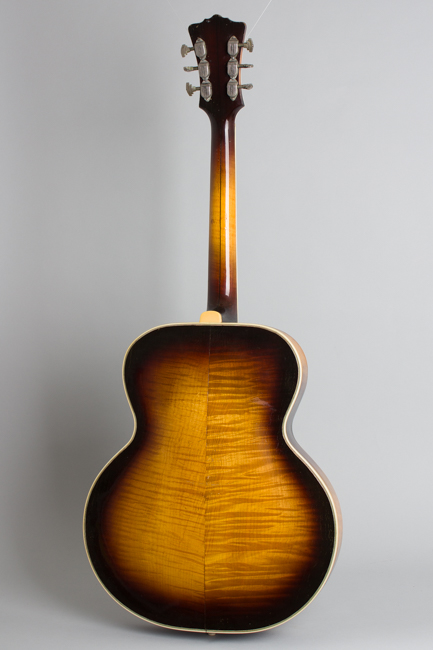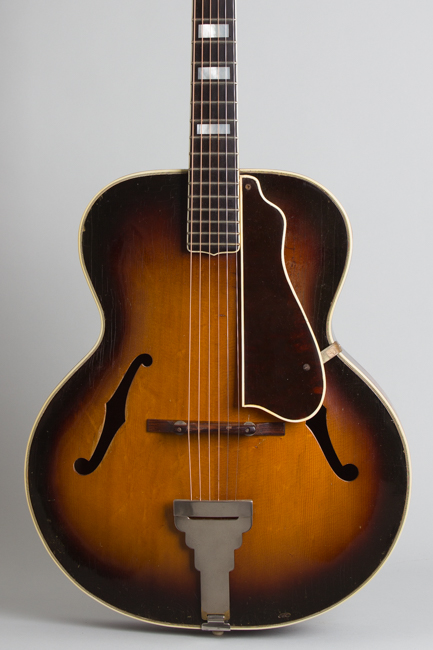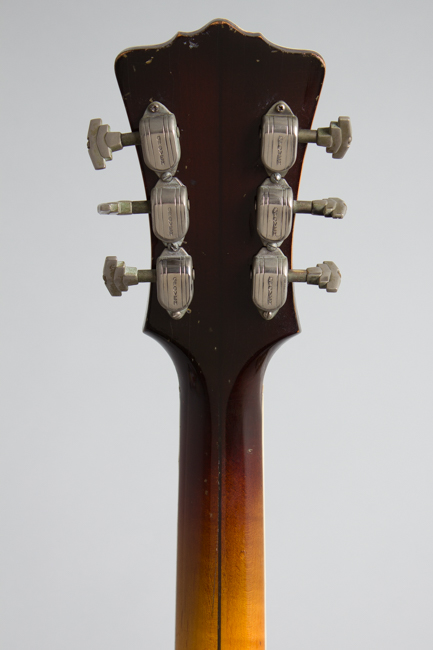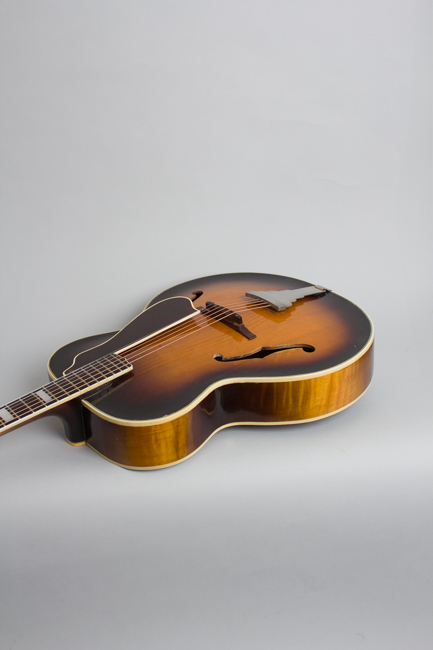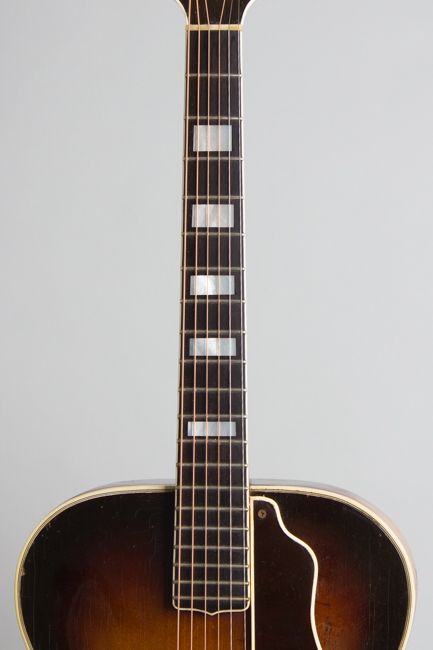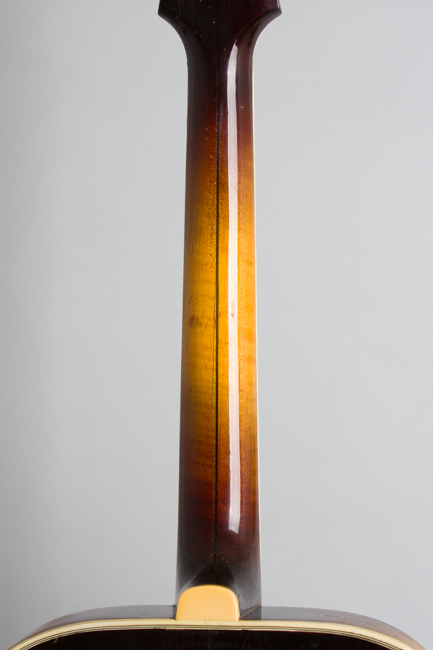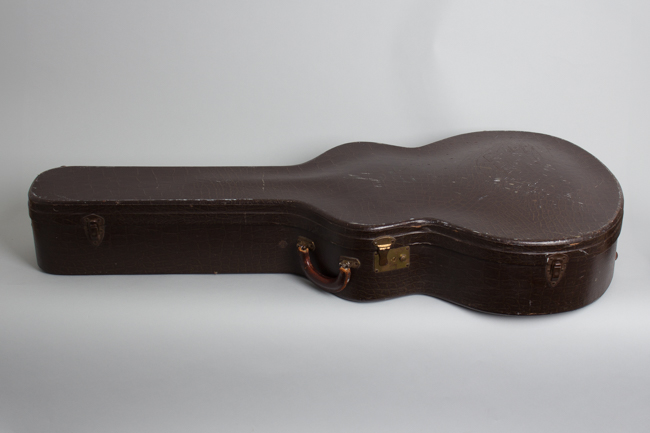D'Angelico Special Arch Top Acoustic Guitar (1947)
D'Angelico Special Model Arch Top Acoustic Guitar (1947), made in New York, NY, serial # 1757, sunburst lacquer finish, maple back and sides, spruce top; lamin ated maple neck with ebony fingerboard, original brown hard shell case.
This is a lovely if relatively modest example of the work of the man considered the undisputed dean of arch top guitar builders, John D'Angelico. John's instruments took inspiration from Gibson and Epiphone but combined them with his own aesthetics and craftsmanship into a personal recipe for the perfect guitar. This 1947 "Special" is a unique instrument; a professional grade guitar but made to a budget, not as heavily ornamented as the top-line models. It is generally similar to the earlier Style B guitars that were being phased out at the time, made for a player who wanted the best but on a budget.
This guitar has a 17 3/16" wide body, a bit larger than the 1940s Gibson L-5 and closer to Epiphone's professional models. Despite being crafted to a lower price point, this "Special" is built with the same care and materials as John's Excel and New Yorker models. The hand carved top is tight grained spruce and the back and sides are maple, with a fairly flashy tiger grain pattern on the back. The top and back are 5-ply bound and finished in a beautiful dark blended sunburst. The top is carved thinner than some D'Angelicos and is parallel braced, with unbound traditionally shaped f-holes.
The neck is laminated maple, with a very comfortable shallow "C" profile and 1 11/16" nut width fabricated from 2 outside maple pieces with a thin dark wood center laminate. The fingerboard is ebony, single bound with pearl block inlay. The headstock is single bound and carries an inlaid "D'Angelico, New York" script logo not in pearl but in ivoroid. There is an unengraved shield inlay lower on the headstock, also made of plastic instead of pearl. Likely the original owner (more on him later!) saved a few dollars with that request.
The tailpiece is an inexpensive off-the-shelf piece, the bridge is carved rosewood with an angled saddle in the typical D'Angelico pattern. Overall this guitar is similar to later Style B's, although the plating is nickel and not gold. The tuners are 1950s Grover Imperials, of the period but not original to this guitar which likely had openback machines originally. The mounting flanges on the housings were neatly trimmed to fit them to the headstock; it's certainly possible John did this upgrade for the customer himself.
This guitar is listed in D'Angelico's ledger as completed on 06/05/47, sold to a player named Frank Salato. Amazingly enough the original typed receipt is still in the case, showing the guitar as "D'Angelico special, dark finish" priced at $200, plus $25 for the case. Mr. Salato lived in Brooklyn on 18th street, about a half hour walk from where our shop stands today. One hopes this guitar served him well; it has been carefully played for many decades since and remains better preserved than many.
The tone of this very responsive guitar is incisive, as Swing-era instruments needed to be, but with an overriding roundness and balance that is the hallmark of D'Angelico. Compared to his more expensive and ornate creations, it still offers a comparable sound -- indeed, some players have preferred the more basic models over the years. Visually this "Special" is far from D'Angeligo's fanciest instrument but remains a fantastic sounding archtop, a true gem built by one of the greatest guitar makers of the 20th century.
Overall length is 41 1/2 in. (105.4 cm.), 17 3/16 in. (43.7 cm.) wide at lower bout, and 3 1/4 in. (8.3 cm.) in depth, measured at side of rim. Scale length is 24 3/4 in. (629 mm.). Width of nut is 1 11/16 in. (43 mm.).
This is a lightly played-in guitar but not too heavily used; it remains nicely original showing signs of use and typical minor repairs. There is fairly light wear to the all-original finish in the form of checking, scratches, scrapes and dings, but no large areas worn through the lacquer. There is some discoloration to the top under the pickguard from the original celluloid guard outgassing long ago, but less damage there than some. The edges of the bass side F-hole show some light moisture damage. The upper side of the fingerboard extension has the typical "vampire bites" from an old DeArmond pickup installation.
The instrument shows some typical seam repairs common to many older archtops. There is a long re-seal to the lamination seam along the back of the neck, moving slightly into the maple between the 5th and 10th fret areas. This is completely solid but not finished over so visible. The center seam on the back has also been resealed at both ends, also with no overfinish. Apart from these seam repairs there are no splits or cracks to the wood.
The bridge and tailpiece remain original; the bridge top has a small intonation notch added for the B string. As noted the vintage Grover Imperial tuners appear to be a period upgrade; the plating is somewhat worn but these beautiful top-grade machines still work well. The pickguard is a correct repro using the original binding. Neither the pickguard or binding show any signs of Celluloid deterioration or distress. The guitar appears to have been refretted decades ago with wire similar to the original; these frets show some subsequent wear. The fingerboard was likely trued at the time and shows hardly any wear at all.
This is simply a superbly fine-playing and sounding guitar, substantially unaltered from John D'Angelico's original creation with just typical maintenance repairs. Although a lower-priced model than an Excel or New Yorker it sounds as wonderful as they usually do and still functions perfectly even after nearly 80 years. It still rests in the original hardshell case that has some noticeable deterioration to the lining on the lower side caused by the original pickguard distress but is still solid and functional. Overall Very Good + Condition.
This is a lovely if relatively modest example of the work of the man considered the undisputed dean of arch top guitar builders, John D'Angelico. John's instruments took inspiration from Gibson and Epiphone but combined them with his own aesthetics and craftsmanship into a personal recipe for the perfect guitar. This 1947 "Special" is a unique instrument; a professional grade guitar but made to a budget, not as heavily ornamented as the top-line models. It is generally similar to the earlier Style B guitars that were being phased out at the time, made for a player who wanted the best but on a budget.
This guitar has a 17 3/16" wide body, a bit larger than the 1940s Gibson L-5 and closer to Epiphone's professional models. Despite being crafted to a lower price point, this "Special" is built with the same care and materials as John's Excel and New Yorker models. The hand carved top is tight grained spruce and the back and sides are maple, with a fairly flashy tiger grain pattern on the back. The top and back are 5-ply bound and finished in a beautiful dark blended sunburst. The top is carved thinner than some D'Angelicos and is parallel braced, with unbound traditionally shaped f-holes.
The neck is laminated maple, with a very comfortable shallow "C" profile and 1 11/16" nut width fabricated from 2 outside maple pieces with a thin dark wood center laminate. The fingerboard is ebony, single bound with pearl block inlay. The headstock is single bound and carries an inlaid "D'Angelico, New York" script logo not in pearl but in ivoroid. There is an unengraved shield inlay lower on the headstock, also made of plastic instead of pearl. Likely the original owner (more on him later!) saved a few dollars with that request.
The tailpiece is an inexpensive off-the-shelf piece, the bridge is carved rosewood with an angled saddle in the typical D'Angelico pattern. Overall this guitar is similar to later Style B's, although the plating is nickel and not gold. The tuners are 1950s Grover Imperials, of the period but not original to this guitar which likely had openback machines originally. The mounting flanges on the housings were neatly trimmed to fit them to the headstock; it's certainly possible John did this upgrade for the customer himself.
This guitar is listed in D'Angelico's ledger as completed on 06/05/47, sold to a player named Frank Salato. Amazingly enough the original typed receipt is still in the case, showing the guitar as "D'Angelico special, dark finish" priced at $200, plus $25 for the case. Mr. Salato lived in Brooklyn on 18th street, about a half hour walk from where our shop stands today. One hopes this guitar served him well; it has been carefully played for many decades since and remains better preserved than many.
The tone of this very responsive guitar is incisive, as Swing-era instruments needed to be, but with an overriding roundness and balance that is the hallmark of D'Angelico. Compared to his more expensive and ornate creations, it still offers a comparable sound -- indeed, some players have preferred the more basic models over the years. Visually this "Special" is far from D'Angeligo's fanciest instrument but remains a fantastic sounding archtop, a true gem built by one of the greatest guitar makers of the 20th century.
Overall length is 41 1/2 in. (105.4 cm.), 17 3/16 in. (43.7 cm.) wide at lower bout, and 3 1/4 in. (8.3 cm.) in depth, measured at side of rim. Scale length is 24 3/4 in. (629 mm.). Width of nut is 1 11/16 in. (43 mm.).
This is a lightly played-in guitar but not too heavily used; it remains nicely original showing signs of use and typical minor repairs. There is fairly light wear to the all-original finish in the form of checking, scratches, scrapes and dings, but no large areas worn through the lacquer. There is some discoloration to the top under the pickguard from the original celluloid guard outgassing long ago, but less damage there than some. The edges of the bass side F-hole show some light moisture damage. The upper side of the fingerboard extension has the typical "vampire bites" from an old DeArmond pickup installation.
The instrument shows some typical seam repairs common to many older archtops. There is a long re-seal to the lamination seam along the back of the neck, moving slightly into the maple between the 5th and 10th fret areas. This is completely solid but not finished over so visible. The center seam on the back has also been resealed at both ends, also with no overfinish. Apart from these seam repairs there are no splits or cracks to the wood.
The bridge and tailpiece remain original; the bridge top has a small intonation notch added for the B string. As noted the vintage Grover Imperial tuners appear to be a period upgrade; the plating is somewhat worn but these beautiful top-grade machines still work well. The pickguard is a correct repro using the original binding. Neither the pickguard or binding show any signs of Celluloid deterioration or distress. The guitar appears to have been refretted decades ago with wire similar to the original; these frets show some subsequent wear. The fingerboard was likely trued at the time and shows hardly any wear at all.
This is simply a superbly fine-playing and sounding guitar, substantially unaltered from John D'Angelico's original creation with just typical maintenance repairs. Although a lower-priced model than an Excel or New Yorker it sounds as wonderful as they usually do and still functions perfectly even after nearly 80 years. It still rests in the original hardshell case that has some noticeable deterioration to the lining on the lower side caused by the original pickguard distress but is still solid and functional. Overall Very Good + Condition.


